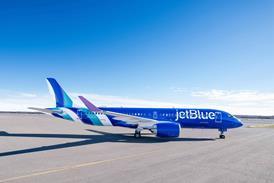Military airframer Lockheed Martin says it is closing in on a firm contract with the US Department of Defense for the next two rounds of F-35 production.
Speaking at a UBS industrial conference on 3 December, Lockheed’s chief financial officer Jay Malave said the company has a “handshake” deal with the Pentagon covering Lot 18 and 19 orders of the stealthy single-engined fighter – with a formal agreement likely to be reached in the coming weeks.
“We’re getting close,” Malave says. “I’m bullish that we’ll get there by the end of the year.”
The timing of that contract could impact Lockheed’s final reported financials for 2024, at least on paper. If the defence giant and the US government agree to terms late in December, the revenue associated with F-35 programme costs already incurred would not post until January – rolling it into 2025 figures.
Malave describes that possibility as a “timing impact” rather than a substantial issue for the company.

Without providing specifics, he reveals that Lockheed and the Pentagon have agreed upon the “general critical terms” of a Lot 18 and 19 deal, including delivery prices for the tri-variant F-35. Both parties are currently reviewing the proposed contract.
“That should hopefully be done here this month,” Malave says.
Once the deal for Lots 18 and 19 is formally inked, Lockheed and the Pentagon will start negotiations for the subsequent Lot 20 round of production. Those aircraft are not expected for delivery until 2027 or 2028.
One major question about the forthcoming F-35 contracts is whether the per-aircraft price will increase. That would mark a reversal to the previous trend of falling prices, as the F-35 assembly capacity has reached maturity.
Lockheed currently produces 156 jets per year, with the 1,000th F-35 rolling off the Fort Worth assembly line earlier this year.
Those efficiencies have been undercut by the enduring impacts of the Covid-19 pandemic, including higher material and labour costs. Malave says Lockheed has “by and large” been able to keep cost increases on the F-35 programme below the overall rate of inflation.
However, he caveats that costs on aircraft production are going up, driven by general inflationary effects and F-35 modernisation efforts such as the troubled Technical Refresh 3 initiative.
Engineering and certification challenges on that effort to upgrade the F-35’s onboard computer processing power led to a year-long halt on aircraft deliveries. Although it began accepting the new jets in August, the Pentagon is withholding a portion of final payment on each F-35 until Lockheed fully resolves the technical issues.

Lockheed is currently delivering aircraft at rates beyond its normal production capacity, as it works through the backlog of completed F-35s built up during the acceptance pause. Chief executive James Taiclet says the company plans to turnover 180 stealth fighters in 2025 and beyond.
Despite the modernisation issues, Malave says the company continues to see strong demand for new F-35 purchases, in addition to increasing sustainment revenue from the growing worldwide fleet.
In November, Romania became the latest country to finalise its F-35 acquisition plans, becoming the 20th global buyer with a 32-aircraft order valued at up to $7.2 billion.
The fifth-generation fighter has also proven its battlefield effectiveness over the past year, including the first known combat sorties by the carrier-capable F-35C.
Malave says Lockheed is seeing “significant international demand” for the F-35, primarily from Europe and the Middle East. However, unlike many other fighter aircraft on the market, the US government restricts access to the advanced stealth jet, somewhat limiting Lockheed’s future growth potential.
NATO ally Turkey was famously booted from the programme in 2019, with subsequent negotiations to re-enter the F-35 club largely unproductive.
As the number of potential new customers dwindles, Malave says income from F-35 production will flatten out and the programme will shift to a sustainment-focused revenue model.
“We still expect there to be strong growth on the sustainment side,” he says.
With that dynamic in mind, Lockheed does not have any plans to expand F-35 production beyond the current level of 156 aircraft annually.
“We’re pretty locked in to 156,” Malave says. “I don’t see that changing any time soon.”
He notes it would require a “pretty substantial” investment across the entire F-35 supply chain to reach even an annual output level in the 160s or 170s.































